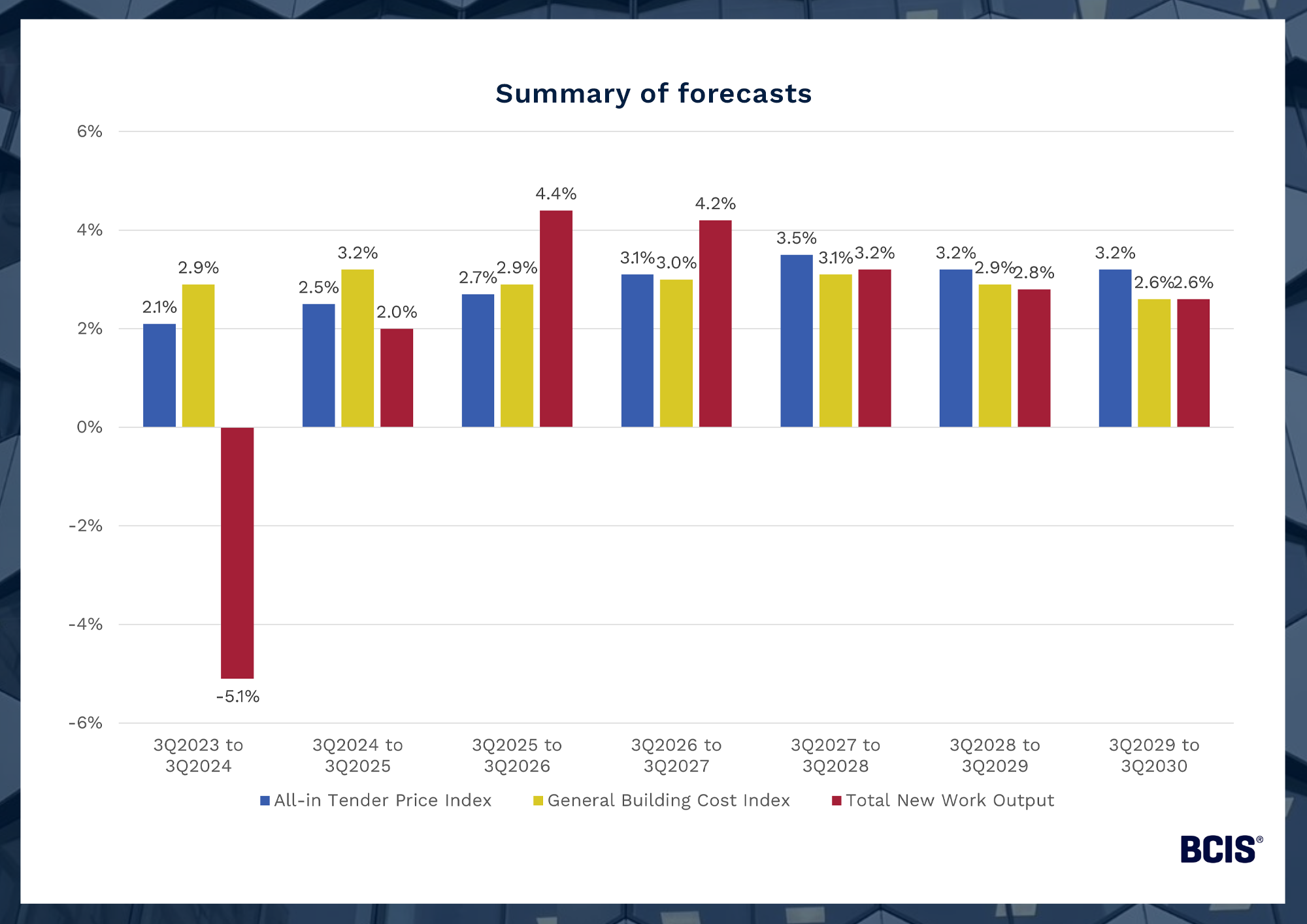The Building Cost Information Service (BCIS) is the leading provider of cost and carbon data to the UK built environment. Over 4,000 subscribing consultants, clients and contractors use BCIS products to control costs, manage budgets, mitigate risk and improve project performance. If you would like to speak with the team call us +44 0330 341 1000, email contactbcis@bcis.co.uk or fill in our demonstration form
Published: 02/10/2025
BCIS produces five-year construction industry forecasts, covering projected costs, tender prices and output, and examining the latest construction market trends.
The quarterly BCIS building briefing presents our view of housing, infrastructure, public non-housing, private industrial and private commercial new work output against the backdrop of materials and labour costs, and the wider economic background and market conditions.
The full briefings are available to subscribers of BCIS CapX, the leading service for construction costing activities.
BCIS construction industry forecast – 3Q2025 to 3Q2030
Building costs will increase by a predicted 15% over the next five years, while tender prices will rise by 16% over the same period, according to our latest construction forecast data.
New work output is expected to grow by 18% between 2025 and 2030.
Dr David Crosthwaite, Chief Economist at BCIS, said: ‘Heading into the last few months of the year, the “get Britain building” rhetoric hasn’t yet turned into delivery. Demand is broadly flat and inflation is sticky, leaving a stagflation-type squeeze: weak growth on one side, elevated labour and materials on the other, and margins under pressure. We therefore expect only a modest uptick in output in 4Q2025.’
The BCIS All-in Tender Price Index, which measures the trend of contractors’ pricing levels in accepted tenders, i.e. the cost to client at commit to build, saw annual growth of 2.5% in 3Q2025.
On the input costs side, labour remains the main driver of project costs, with increases to employers’ National Insurance Contributions and the National Living Wage feeding into a 7.1% annual increase in the BCIS Labour Cost Index in 2Q2025. The index is forecast to increase overall by 15% between 3Q2025 and 3Q2030.
Dr Crosthwaite added: ‘Similarly to previous forecasts, labour cost risks remain on the upside, as skills shortages remain prevalent in the market and continue to impact projects. Likewise, while overall materials costs remain stable, the expected increase in market activity going forward could put inflationary pressure on the cost of construction materials.’
With 0.5% annual growth in the BCIS Materials Cost Index forecast for 3Q2025, BCIS expects costs to increase by 13% over the forecast period (to 3Q2030).
Total new work output fell by 5.1% between 2023 and 2024 and BCIS still expects subdued growth in new work output throughout 2025. ONS data showed a 1.1% increase in new work output in the second quarter of 2025 compared with 1Q2025, and an annual increase 3.8%. The greatest annual increase in new work output in 2Q2025 was in infrastructure, which showed a 3.2% rise.
Dr Crosthwaite said: ‘We are expecting more robust new work output growth from next year and over the rest of the forecast period. Momentum should build in 2026 as delayed schemes progress, public investment starts to land and housing activity recovers.’
Source: BCIS, ONS
BCIS forecast of new work output at constant 2022 prices. Total new work output is whole year on year.
The full forecast of prices, costs and demand, covering 2025 to 2030, is available to subscribers of BCIS CapX.
To keep up to date with the latest industry news and insights from BCIS register for our newsletter here.
Quarterly updates to forecasts are published for building, infrastructure, and maintenance, cleaning and energy, while an annual update is published for the economic significance of maintenance.
Latest infrastructure forecast

